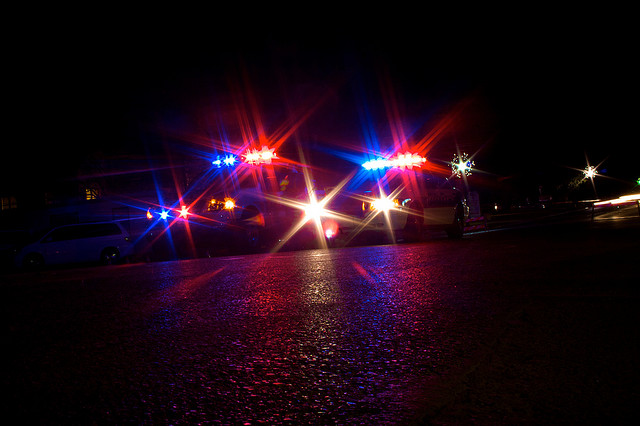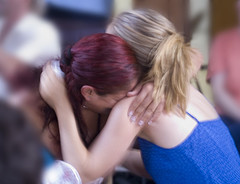READ: Processing a Crime Scene
| Site: | Mountain Heights Academy OER |
| Course: | Medical Forensics Q1 |
| Book: | READ: Processing a Crime Scene |
| Printed by: | Guest user |
| Date: | Sunday, 27 July 2025, 5:03 PM |
Defining the Boundaries of the Scene
Processing a crime scene
The first person to arrive at a crime scene is typically a police officer. The first priority of the responding officer is to make sure that anyone at the scene that needs medical attention receives help. The second priority is to protect and secure the scene. In order to accomplish both of these tasks the responding officer should analyze the scene and determine what help is needed. This will depend on the type of crime committed, the state of the people at the scene, and the type and size of the scene. The officer may need to call for backup police officers, emergency medical services, crime scene investigators, or the fire department depending on the situation at the scene.

Defining the Boundaries of the Scene
In order to secure the scene the responding officer will need to determine what area to rope off as the crime scene. The crime scene should include the area where the crime occurred as well as any areas where possible evidence might be located. Sometimes this can be difficult to do because it can be hard to determine where related evidence might be located. The first thing to do is to identify the center of the crime scene. The center of a crime scene is often easy to identify. It is typically where the actual crime has taken place or a where a victim is located. The boundaries of a crime scene can be harder to define. Items and evidence related to the crime may be located away from where the actual crime occurred. The scene can also be different depending on whether it occurred inside or outside. The officer will also want to make sure that the entry and exit points of the suspect are included in the scene. Once these are identified the officer will try to establish a pathway for medical personnel and investigators to use that follows a different route than the suspect if possible. This ensures that any evidence in left behind will be preserved.
Crime scenes can range from an individual room to an entire house and yard, or a whole building, or a large outdoor area depending on what happened. Crime scenes may also include vehicles that may have been involved in the crime. The responding officer must consider the area where evidence is most likely located and take steps to protect that area. In order to do this the officer can rope off the area with police tape, rope, traffic cones or other barricades. If the scene is limited to a room inside a home or building it is relatively easy to keep unauthorized people out of the scene, but if it is outdoors or a larger area, the task is more difficult and will require help from other police officers as they arrive.

Some of the people that may want to enter the scene could be family members of victims, neighbors, or just curious people passing by. There could also be members of the media that want to report on the scene. Other police officers and officials may want to see the scene as well. The only people that should be allowed in the scene are authorized medical personnel, if needed, authorized police officers, and investigators working directly with the scene.
It is important that the number of people that enter the scene is limited to only those that need to be involved. This helps to protect the evidence and reduce possible contamination that can occur by allowing people into the scene. Every time someone enters the scene there is a chance that they will alter the evidence by moving or touching it. There is also the possibility that they will introduce new materials that might be mistaken as evidence such as hairs or fibers from their clothes. Investigators often wear shoe covers, gloves, and hair covers into a scene to prevent contamination as much as possible.
Other Considerations
The first responding officer has many responsibilities at the crime scene. Another thing that they should do is begin to document and take notes about what they observe at the scene. Some evidence may only be detectable at the scene for a short time. Some examples of this type of evidence could be smells, temperature, vehicles at the scene or the presence of smoke at the scene. The officer should take notes recording this type of evidence so that they can share it with the investigation team when they arrive.
The officer that secures the scene should also keep a record of who enters and exits the scene. They should also record the time that people enter and exit the scene in case there are questions that come up later in the investigation about who was let into the scene. In addition to securing the scene they should take statements from the victims and record them in their notes. They should also make sure that any witnesses or possible suspects are held until statements can be taken from them. If medical assistance was called to help a victim, witness, or a suspect at the scene, they should also report any statements made by these people to the investigators.
Everyone at the scene should also be respectful and kind to any family members or friends of the victims that may be at the scene. These people will likely be deeply concerned, upset, and emotional depending on the nature of the crime. The responding officer and other personnel have many responsibilities at the scene, but they should be as respectful and empathetic to family members and friends as possible while maintaining the security of the scene.

Another consideration is that officers and investigators working on the scene should be careful to keep the scene as free from contamination as possible. Those working in the scene should not eat, drink, or do anything that might alter the scene in any way. Every possible step should be taken to avoid changing anything about the scene as much as possible. This means that people working at the scene should eat, take breaks, and use the restroom in another location outside the scene.
Many departments have vehicles dedicated to processing crime scenes. These vehicles include any necessary equipment for processing and packaging evidence at the scene. The crime scene vehicle will often form a sort of command center for the scene so it should be parked in a place that it won't interfere with the scene and will provide enough space for investigators to work.
